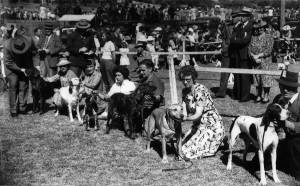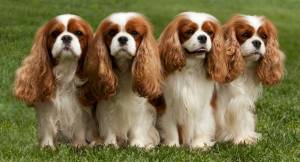Dog Showing over Seven Decades
 Jane with 'Spinky'
Jane with 'Spinky'
Growing up during World War Two, my early memories include a Mini Foxie called 'Spot' who lived across the road. As we had never owned a pet, he taught me what a difference a dog could make in your life. This sparked my lifetime passion for dogs. Consequently, when my father came home from the War, my parents bought me my own pup for my 10th birthday.
They chose a pedigreed Wire Fox Terrier who I called "Spinky". They joined me up with the Kennel Control Council and my lifetime of showing and breeding dogs began. Encouraged by a lovely lady called Aggie Davies, I learned to groom and successfully compete in Junior Handling competitions. I then progressed to Sealyham Terriers. After my marriage, my husband Bob and I founded Rangeaire Airedales and bred 14 generations in direct line, earning 85 Championship titles. Our Airedales and the type they set over the 48 years we were active, lives on through the 17 kennels which began with a 'Rangeaire' connected Airedale. Some these are still active today. In my senior years, I reverted to my childhood memories of 'Spot' and played a major role in developing the 'Mini Foxie' into the pure breed known today as the Tenterfield Terrier.
Having actively showing, breeding and judging dogs for the past 7 decades, I believe the following are responsible for changing our dog world:
1. Government Laws
 Kennels of the early 1950s
Kennels of the early 1950s
In the 1950s and 1960s, where I live there were no 'Dog Acts' or Local Council Laws to preclude us keeping as much breeding stock in suburban back yards as we wished. Today and everywhere else it seems, it is a struggle to find ways to run on promising pups. Some serious breeders make room by parting with retired breeding stock. Others buy suitable properties. However, if they produce sufficient puppies to justify their investment, they might have Government Laws to contend with'!
2. Promotion and Communication
In the late 1940's and early 1950's, there was only a fraction of the Shows we have today. Consequently each win carried more prestige. Additionally, there was very little photography, no internet, and no affordable air travel. Importation into Australia was rare because the dogs had to endure months both at sea through the tropics and in quarantine. Those of us without 'wheels' were picked up and taken to Shows by bus. There was very little gear - no gazebos, no tents, no tables and sometimes even no chairs! Consequently, there was lots of opportunity to chat. Today gazebos isolate different groups of people. That is one factor that hinders rather than encourages open discussion. I believe this change of situation also has had a major impact not only on breeding but also on the atmosphere outsiders and the general public find around our modern dog show rings.
3. Political Correctness
 Dog Show late 194os
Dog Show late 194os
Because air travel used to be prohibitively expensive and difficult, we had to select our breeding dogs from local dogs by watching the breed judging intently. We then selected the dog that best suited our bitch. As so many of us travelled together and then sat or stood together around the ring, we openly discussed the dogs being judged in front of us.
Today 'political correctness' has changed this. Open discussion is too often seen as unfair criticism and creates arguments. Instead, when choosing a stud dog or a bitch for breeding, potential breeders make this choice from the dogs that are well promoted. Consequently, the useful ringside discussions of days gone by, have disappeared. The show ring of today is no longer the shop window where breeds are openly discussed.
The Solution?
 Cavalier King Charles SpanielsIf the show ring of today provided more emphasis at breed rather than at group or in-show level and openly discussed the dogs, it might help to sort out the genuine breeders. A dog show should provide a platform for open discussion. Breed Standards should be studied and senior breeders respected. Then newcomers would have the means to be educated into developing an 'eye' to recognise the salient points in different pure breeds. This would put them in a better position to select and judge breeding stock.
Cavalier King Charles SpanielsIf the show ring of today provided more emphasis at breed rather than at group or in-show level and openly discussed the dogs, it might help to sort out the genuine breeders. A dog show should provide a platform for open discussion. Breed Standards should be studied and senior breeders respected. Then newcomers would have the means to be educated into developing an 'eye' to recognise the salient points in different pure breeds. This would put them in a better position to select and judge breeding stock.
Many of Australia's most respected dog people grew up during the period when people were happy to openly discuss dogs, good and bad, without fear or favour. Perhaps we should wind the clock back to those days that we senior dog people remember as the as 'the best times of our dog world'.